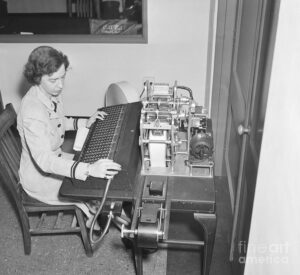Accept Cookies & Privacy Policy?
We use cookies to ensure that we give you the best experience on our website. If you continue to use this site we will assume that you accept and understand our Privacy Policy, and our Terms of Service.
From humble beginnings to the cutting-edge innovations of today, test automation has evolved into an indispensable cornerstone of modern development practices. As we continue to push the boundaries of technological possibility.. Delve into the annals of technological advancement and discover how test automation has shaped the landscape of software testing.
Our journey began in the infancy of computing, where testing was a predominantly manual endeavor. Developers painstakingly executed test cases by hand, laboring over each line of code to ensure its functionality. With the advent of punch cards and mainframe computers, automated testing emerged as a novel concept, albeit in its rudimentary form.
As computing power surged and software systems became more complex, the need for efficient testing methodologies became paramount. Enter the era of scripted testing, characterized by the development of test scripts and harnesses to automate repetitive tasks. Tools like Rational Robot and WinRunner paved the way for automated testing frameworks, offering developers newfound efficiency and scalability in their testing processes.
With the dawn of the new millennium, the landscape of test automation underwent a seismic shift. The proliferation of agile methodologies and DevOps practices necessitated faster feedback loops and continuous integration. Consequently, a plethora of test automation tools flooded the market, each promising to streamline the testing lifecycle. From Selenium and Appium for web and mobile testing to JUnit and TestNG for unit testing, developers were spoiled for choice when it came to selecting the right tool for the job.
As we venture into the present day, we find ourselves at the forefront of technological innovation. Artificial Intelligence (AI) and Machine Learning (ML) have permeated every facet of software development, including test automation. AI-powered testing tools leverage advanced algorithms to autonomously generate test cases, predict failure scenarios, and optimize test coverage. This marriage of AI and testing holds the promise of revolutionizing the way we approach quality assurance, ushering in an era of unparalleled efficiency and accuracy.
With emerging technologies like robotic process automation (RPA) and quantum computing on the horizon, the future of test automation is brimming with untapped potential. As software systems evolve and become increasingly intricate, so too will the tools and methodologies we employ to ensure their reliability and resilience.
The first recorded instance of automated testing is attributed to the creation of "The Compiler Compiler" by Grace Hopper, a program that automatically generated machine code from human-readable instructions.

The introduction of the Pascal-based testing tool, "Pascal-based test tool (PBTT)," marks an early foray into automated testing methodologies.

The development of low-code/no-code test automation platforms democratizes testing, empowering non-technical users to create and execute automated tests with ease.
These milestones represent pivotal moments in the evolution of test automation, each contributing to the rich tapestry of advancements that have shaped the landscape of software testing over the decades.
Adoption of Kubernetes for test automation orchestration increases, allowing teams to efficiently manage and scale test execution environments in containerized environments.
The use of synthetic monitoring tools such as New Relic and Datadog gains traction for automated performance and availability testing in production environments.
Integration of observability tools like Jaeger and Prometheus into test automation frameworks enhances the ability to monitor and analyze application behavior during automated tests.
Continued growth of AI-driven testing solutions sees the introduction of advanced anomaly detection algorithms for identifying subtle defects missed by traditional testing approaches.
Expansion of robotic process automation (RPA) capabilities in test automation frameworks enables the automation of repetitive manual tasks such as data setup and cleanup.
Increased focus on accessibility testing leads to the development of automated testing tools and frameworks specifically designed to evaluate web and mobile applications for compliance with accessibility standards.
Parting Thoughts
These recent developments reflect the ongoing evolution of test automation, driven by advancements in technology and the ever-changing demands of modern software development practices.
In addition to its historical trajectory, it’s noteworthy to highlight the role of automation testing in improving software quality, accelerating development cycles, and reducing costs. Additionally, the evolution of automation testing tools and methodologies has led to increased adoption across industries, driving innovation and efficiency in software development processes.
Thought Frameworks is a U.S.-based leading QA and software testing organization that’s been in business since 2009, armed with the ultimate solutions for all your software’s QA testing challenges. Having headquarters both in California, USA and a fully functional well equipped QA Test Lab in Bengaluru-India, that delivers premium QA and QC services endlessly across different Industry domains and niches. A CMMI Level 3 ISTQB Silver Partnered Company, our superhuman test team heroes have delivered numerous successful QA and QC projects for clients across the globe. Get powered by our deep dive bug-hunting process that helps your software in clocking release cycles on time while delivering excelling quality and functionality.

Imagine a world where testing is no longer a bottleneck. No more endless cycles of manual effort, no more missed defects due to human fatigue, and no more panic at the eleventh hour before a major ERP rollout.

Imagine a world where testing is no longer a bottleneck. No more endless cycles of manual effort, no more missed defects due to human fatigue, and no more panic at the eleventh hour before a major ERP rollout.

Let’s talk about GenAI and testing in 2025—the wild west of technology where machines are not just smart, but scary smart. GenAI (that’s Generative AI for the uninitiated) is running the show everywhere. It’s writing poetry, designing ads, debugging code, and probably plotting to take over my job as I write this blog.

Ah, 2024—you’ve been a year, haven’t you? For us at Thought Frameworks, this year wasn’t just about running the usual QA/QE playbook. Nope, we went full throttle into the future—tinkering, testing, and transforming everything from ERP systems to the ever-evolving world of SAP, GenAI, and security testing.

So, you’re deep in the ERP trenches and trying to figure out the best approach between NetSuite and Oracle EBS. You’re certainly not alone! We can help break down how these two ERP giants stack up when it comes to ensuring systems run like clockwork but without the overload.

Ah, Christmas. The season of jingling bells, endless carols, and holiday sales that test our wallets’ patience! But you know what else gets tested this time of year? Software. Yep, behind the tinsel and gingerbread lattes, there’s a whole lot of testing going on.
Accept Cookies & Privacy Policy?
We use cookies to ensure that we give you the best experience on our website. If you continue to use this site we will assume that you accept and understand our Privacy Policy, and our Terms of Service.
| Cookie | Duration | Description |
|---|---|---|
| cookielawinfo-checkbox-analytics | 11 months | This cookie is set by GDPR Cookie Consent plugin. The cookie is used to store the user consent for the cookies in the category "Analytics". |
| cookielawinfo-checkbox-functional | 11 months | The cookie is set by GDPR cookie consent to record the user consent for the cookies in the category "Functional". |
| cookielawinfo-checkbox-necessary | 11 months | This cookie is set by GDPR Cookie Consent plugin. The cookies is used to store the user consent for the cookies in the category "Necessary". |
| cookielawinfo-checkbox-others | 11 months | This cookie is set by GDPR Cookie Consent plugin. The cookie is used to store the user consent for the cookies in the category "Other. |
| cookielawinfo-checkbox-performance | 11 months | This cookie is set by GDPR Cookie Consent plugin. The cookie is used to store the user consent for the cookies in the category "Performance". |
| viewed_cookie_policy | 11 months | The cookie is set by the GDPR Cookie Consent plugin and is used to store whether or not user has consented to the use of cookies. It does not store any personal data. |
Ready for a Quality Software?
Let’s Dig Deep Into Your Thought!